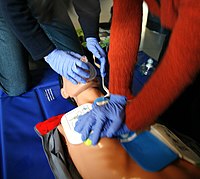
Photo from wikipedia
The European Resuscitation Guidelines recommend that survivors of cardiac arrest (CA) be resuscitated with 100% O 2 and undergo subsequent—post-return of spontaneous circulation (ROSC)—reduction of O 2 supply to prevent… Click to show full abstract
The European Resuscitation Guidelines recommend that survivors of cardiac arrest (CA) be resuscitated with 100% O 2 and undergo subsequent—post-return of spontaneous circulation (ROSC)—reduction of O 2 supply to prevent hyperoxia. Hyperoxia produces a “second neurotoxic hit,” which, together with the initial ischemic insult, causes ischemia–reperfusion injury. However, heterogeneous results from animal studies suggest that normoxia can also be detrimental. One clear reason for these inconsistent results is the considerable heterogeneity of the models used. In this study, the histological outcome of the hippocampal CA1 region following resuscitation with 100% O 2 combined with different post-ROSC ventilation regimes (21%, 50%, and 100% O 2 ) was investigated in a rat CA/resuscitation model with survival times of 7 and 21 days. Immunohistochemical stainings of NeuN, MAP2, GFAP, and IBA1 revealed a neuroprotective potency of post-ROSC ventilation with 21% O 2 , although it was only temporary. This limitation should be because of the post-ROSC intervention targeting only processes of ischemia-induced secondary injury. There were no ventilation-dependent effects on either microglial activation, reduction of which is accepted as being neuroprotective, or astroglial activation, which is accepted as being able to enhance neurons’ resistance to ischemia/reperfusion injury. Furthermore, our findings verify the limited comparability of animal studies because of the individual heterogeneity of the animals, experimental regimes, and evaluation procedures used.
Journal Title: Experimental Brain Research
Year Published: 2020
Link to full text (if available)
Share on Social Media: Sign Up to like & get
recommendations!